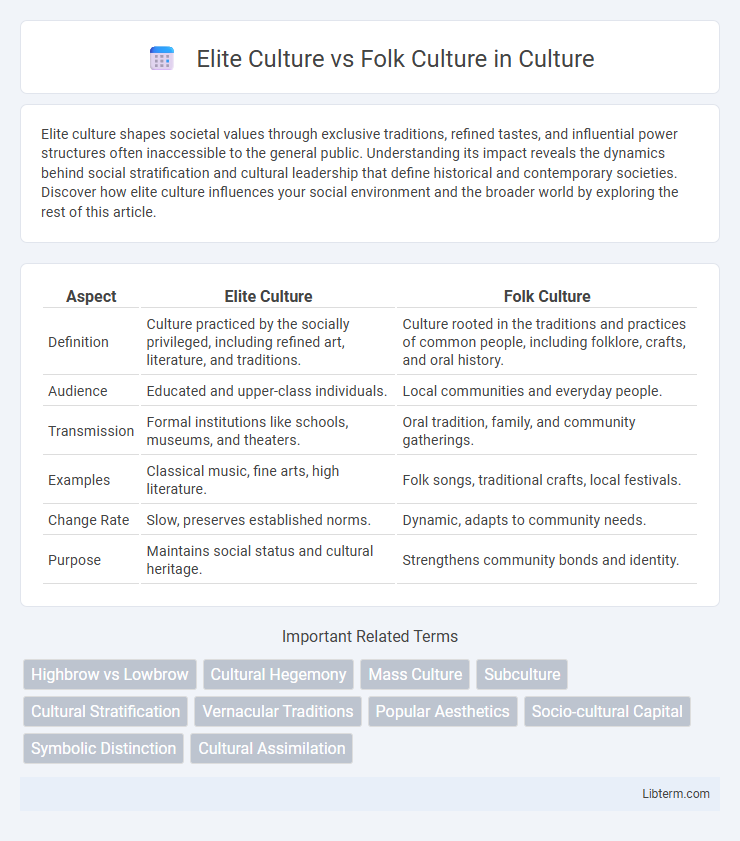Elite culture shapes societal values through exclusive traditions, refined tastes, and influential power structures often inaccessible to the general public. Understanding its impact reveals the dynamics behind social stratification and cultural leadership that define historical and contemporary societies. Discover how elite culture influences your social environment and the broader world by exploring the rest of this article.
Table of Comparison
| Aspect | Elite Culture | Folk Culture |
|---|---|---|
| Definition | Culture practiced by the socially privileged, including refined art, literature, and traditions. | Culture rooted in the traditions and practices of common people, including folklore, crafts, and oral history. |
| Audience | Educated and upper-class individuals. | Local communities and everyday people. |
| Transmission | Formal institutions like schools, museums, and theaters. | Oral tradition, family, and community gatherings. |
| Examples | Classical music, fine arts, high literature. | Folk songs, traditional crafts, local festivals. |
| Change Rate | Slow, preserves established norms. | Dynamic, adapts to community needs. |
| Purpose | Maintains social status and cultural heritage. | Strengthens community bonds and identity. |
Defining Elite Culture and Folk Culture
Elite culture refers to the cultural products, practices, and values associated with the upper echelons of society, often characterized by high art, classical literature, and sophisticated tastes valued by social, economic, and intellectual elites. Folk culture encompasses the traditions, customs, and collective expressions of ordinary people, typically transmitted orally or through community participation, including folk music, dances, rituals, and crafts. Understanding elite and folk culture highlights differences in cultural production, accessibility, and social function in shaping identity and heritage within societies.
Historical Origins and Development
Elite culture originated from organized societies with centralized governance, often linked to aristocracy, royalty, and scholarly classes who controlled resources and knowledge. Folk culture developed through grassroots communities with shared traditions, oral histories, and customs passed down orally and experientially across generations. Historically, elite culture emphasized formal education and written records, while folk culture relied on communal practices and indigenous knowledge systems.
Key Characteristics of Elite Culture
Elite culture is characterized by its association with high social status, specialized knowledge, and aesthetic refinement often linked to intellectuals, artists, and aristocrats. It emphasizes exclusivity, sophisticated artistic expressions, and formal education, frequently preserved and transmitted through institutions like museums, theaters, and universities. This culture tends to prioritize complexity, rarity, and distinction, contrasting sharply with the practical and communal nature of folk culture.
Distinctive Features of Folk Culture
Folk culture is characterized by its community-centered nature, passed down through generations via oral tradition, rituals, and customs unique to specific groups. It emphasizes collective identity, traditional practices, and localized expressions such as folk music, dance, crafts, and folklore that reflect the everyday lives of ordinary people. Unlike elite culture, folk culture often resists commercialization and rapid change, maintaining continuity with historical roots and cultural heritage.
Modes of Transmission and Preservation
Elite culture primarily relies on formal institutions such as museums, universities, and media outlets for the transmission and preservation of its values and artifacts, ensuring controlled, deliberate dissemination through written texts, art, and scholarly works. Folk culture is transmitted orally and through communal rituals, festivals, and traditional practices, emphasizing informal, participatory methods that foster collective memory and cultural continuity within local communities. Preservation in elite culture often involves documentation, archiving, and restoration, whereas folk culture relies on ongoing practice and intergenerational storytelling to maintain its cultural heritage.
Influence on Social Identity and Class
Elite culture shapes social identity by emphasizing exclusivity, high-status symbols, and intellectual achievements, reinforcing class distinctions through access to privileged knowledge and cultural capital. Folk culture reflects collective identity and community values rooted in tradition, often associated with working-class or rural populations, fostering social cohesion and a sense of belonging within specific groups. The interplay between elite and folk cultures highlights tensions in social class dynamics, as cultural preferences signal group membership and influence social mobility.
Elite Culture in Arts, Literature, and Education
Elite culture in arts, literature, and education is characterized by sophisticated expression, often fostering innovation and preserving classical traditions through formal institutions like academies and universities. This culture typically involves access to specialized knowledge, high cultural capital, and patronage systems that support artists, writers, and scholars engaged in elite cultural production. Elite culture emphasizes mastery, critical analysis, and aesthetic refinement, contrasting with the more communal, oral, and vernacular nature of folk culture.
Folk Traditions: Rituals, Music, and Storytelling
Folk culture encompasses rich traditions deeply rooted in community rituals, vibrant music, and oral storytelling that preserve collective heritage and identity. These folk traditions often involve participatory ceremonies, folk songs passed down through generations, and narratives that embody local values and history. The preservation of folk rituals, music, and storytelling plays a crucial role in sustaining cultural continuity and fostering social cohesion within communities.
Modern Interactions and Blurring Boundaries
Elite culture traditionally encompasses the refined tastes and exclusive practices of societal elites, while folk culture represents the shared traditions and customs of common communities. Modern interactions, driven by digital media and global connectivity, are increasingly blurring these boundaries as folk culture influences elite art forms and elite culture incorporates popular and grassroots elements. This convergence fosters hybrid cultural expressions that challenge conventional distinctions and promote inclusive cultural dynamics.
The Future of Elite and Folk Culture in a Globalized World
Elite culture is increasingly shaped by transnational networks of artists, intellectuals, and institutions, leveraging digital platforms to influence global trends and policy-making. Folk culture maintains resilience through localized traditions, languages, and rituals, often supported by grassroots movements and cultural preservation initiatives emphasizing authenticity in the face of globalization. The future of both cultures depends on dynamic interactions where elite culture can facilitate global exposure, while folk culture ensures cultural diversity and heritage continuity amid homogenizing forces.
Elite Culture Infographic

 libterm.com
libterm.com